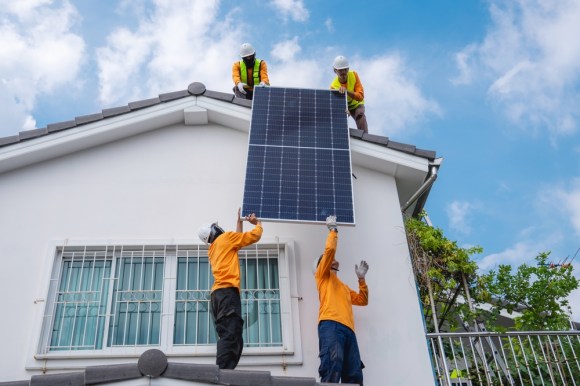From hybrid cars to solar power, clean energy is becoming commonplace. More homeowners than ever are investing in solar power and other clean energy sources.
The cost of solar panel installation is an obstacle for many homeowners. Fortunately, you can save with the solar tax credit, more commonly referred to as the Residential Clean Energy Credit.
What is the solar tax credit?
The solar panel tax credit — or Residential Clean Energy Credit — allows you to recoup a portion of the money you spent on energy-efficient improvements. This federal tax credit is available for both homeowners and renters.
The Residential Clean Energy Credit was created to encourage taxpayers to invest in clean energy. Offering tax incentives for homeowners who switch to solar or geothermal energy makes investing in clean energy more affordable.
While the Residential Clean Energy Credit is often called the solar tax credit, it applies to other clean energy property. Qualifying property includes:
- Solar
- Wind
- Geothermal
- Fuel-cell technology
The Residential Clean Energy Credit offers a dollar-for-dollar reduction of your tax bill This differs from tax deductions which reduce your taxable income. This means the solar credit directly reduces your federal tax liability.
Keep in mind that the Residential Clean Energy Credit can’t exceed the amount you owe in taxes either. Any unused credit can be carried over and applied to your taxes in future years.
The Residential Clean Energy Credit was extended under the Inflation Reduction Act of 2022. You’ll receive the maximum 30% tax credit between 2022 and 2032, with slight reductions for systems installed in 2033 and 2034.
Are there solar tax credits at both the federal and state level?
The Residential Clean Energy Credit is a federal tax credit, which means it reduces the amount you owe in federal taxes. Some states offer a separate solar energy tax credit, helping you save even more when you switch to solar power.
Several states offer solar tax credits. Arizona has the Income Tax Credit for Residential Solar Devices, which allows you to claim up to 25% of the cost or $1,000 — whichever is less.
Oregon offers the Oregon Solar + Storage Rebate Program. This program is based on your income, providing a rebate of up to $5,000 for solar electric systems or up to $2,500 for energy storage systems.
Some cities even offer rebates and financial assistance for homeowners who invest in solar power, including the Boynton Beach Energy Edge Rebate Program and the Dunedin Solar Energy Rebate Grant Program.
Understanding which tax write-offs and credits you qualify for can help you save thanks to your solar investment. If your city or state offers a solar tax credit or rebate, you may be able to claim that, as well as the federal solar tax credit.
Are you eligible? Understanding solar energy tax credit criteria
Before you invest in solar power for your home, you need to understand how tax credits work and who qualifies. Choosing the right clean energy property and understanding the criteria is key.
Qualified Property
Only certain types of residential clean energy property qualify for the Residential Clean Energy Credit. Qualifying clean energy property includes:
- Solar electric panels
- Solar water heaters
- Geothermal heat pumps
- Wind turbines
- Fuel cells
- Battery storage
While this residential clean energy property qualifies for the Residential Clean Energy Credit, there are specific rules about certain types of equipment:
- Solar water heaters: To qualify for the solar tax credit, water heaters must be certified by the Solar Rating Certification Corporation or a state-endorsed entity.
- Geothermal heat pumps: Geothermal heat pumps must meet Energy Star requirements in effect at the time of purchase to qualify.
- Battery storage technology: Battery storage systems must have a minimum capacity of 3 kilowatt hours.
If you’re installing any of this equipment and planning on receiving the Residential Clean Energy Credit, make sure you’re installing qualifying clean energy property.
Another note: All residential clean energy property must be new. Used clean energy property isn’t eligible for the solar tax credit.
Qualified Expenses
In addition to covering the cost of clean energy property, the Residential Clean Energy Credit covers other expenses.
Labor costs are included as qualified expenses, which includes onsite preparation, assembly, and original installation. Labor costs also include the installation of piping or wiring to connect clean energy property to your home.
Structural building components don’t typically qualify. Your tax credit won’t take into account the cost of trusses or asphalt shingles. However, solar shingles and roofing tiles are considered qualified expenses.

Home Use
How you use your home can also impact the solar energy tax credit you receive. Your tax credit may vary based on your homeowner status and whether you use your home for business purposes.
If you’re installing solar panels on a property that’s used exclusively for business, you can’t claim the Residential Clean Energy Credit. If your home is only partly used for business, here’s how it works:
- If you use up to 20% of your home for business purposes, you can claim the full solar tax credit.
- If you use more than 20% of your home for business, your credit is based on the share of equipment and installation costs that can be allocated to nonbusiness use.
You can qualify for the Residential Clean Energy Credit if you own your home. You can even claim this credit on a second home if you reside in it and don’t rent it out If you rent a home, you can qualify for the solar energy tax credit if you invested in clean energy property.
Rebates and Incentives
Certain rebates and incentives may impact your solar tax credit. Many subsidies, rebates, and incentives are considered purchase-price adjustments, which means they should be subtracted from your expenses to calculate your credit.
State energy incentives and tax credits typically don’t need to be subtracted from your expenses to calculate your tax credit. While some rebates are considered purchase-price adjustments, many state tax incentives don’t legally qualify as rebates.
Filing for your solar tax credit: A step-by-step guide
If you installed qualifying residential clean energy property in the last year, you can calculate and claim your tax credit by filling out Form 5695, Residential Energy Credits.
Start by entering your name and the address of the property for which you’re claiming the tax credit. For lines 1–4, enter the qualified residential clean energy property costs you paid.
Lines 5a and 5b are for battery storage technology. If you didn’t install qualified battery storage technology in addition to solar, you can check no and skip to lines 6a and 6b. If you checked yes, enter qualified battery storage expenses in line 5b.
Next, add lines 1–5b and multiply that number by 30% (0.30). Lines 7–11 only apply to fuel cell property, so you can skip them if they don’t apply to you.
For line 14, subtract any credits or adjustments you’re claiming on your tax return from line 18 on Form 1040 to calculate your limitation based on tax owed. If line 14 is less than line 13, you’ll carry the remainder of the credit forward to next year.
The second part of Form 5695 allows you to calculate your energy-efficient home improvement credit. Use this section to calculate your tax credit for insulation, doors and windows, and other energy-efficient upgrades.
While Form 5695 is relatively straightforward and detailed instructions are available, it can be overwhelming. You may want to consult a tax professional to make sure you’re accurately calculating your solar tax credit.
Maximize benefits by taking advantage of other write-offs
Federal tax credits and tax deductions aren’t mutually exclusive. When you file your taxes, you can claim the Residential Clean Energy Credit in addition to other deductions and write-offs to save even more.
For example, as a homeowner, you can use the mortgage interest deduction to reduce your taxable income. You can write off mortgage interest expenses paid during the year for loan balances of up to $750,000 as a single filer or married couple filing jointly or $375,000 for each party if you’re married but filing separately. If your loan was obtained prior to December 16, 2017, your loan limit is $1,000,000 or $500,000 if married filing separately.
The State and Local Tax (SALT) deduction allows you to write off property taxes along with local and state income taxes or just state and local sales taxes. This deduction is up to $5,000 per year if you file using either the single filing status or are married filing separately. If you’re a married couple filing jointly, you’re entitled to a $10,000 deduction per year. In higher-income areas, the SALT deduction can lead to significant savings.
Keep in mind that you’ll need to itemize your deductions on your tax return to claim most of the tax write-offs and deductions that are available to homeowners. For some people, claiming the standard deduction is a better financial decision. Use this calculator to see which is better for you.
If you’re not sure itemizing deductions is beneficial for you, TurboTax is here to help. No matter what moves you made last year, TurboTax will make them count on your taxes. Whether you want to do your taxes yourself or have a TurboTax expert file for you, we’ll make sure to help you find and claim deductions and tax credits you’re eligible for, get every dollar you deserve, and your biggest possible refund – guaranteed.








